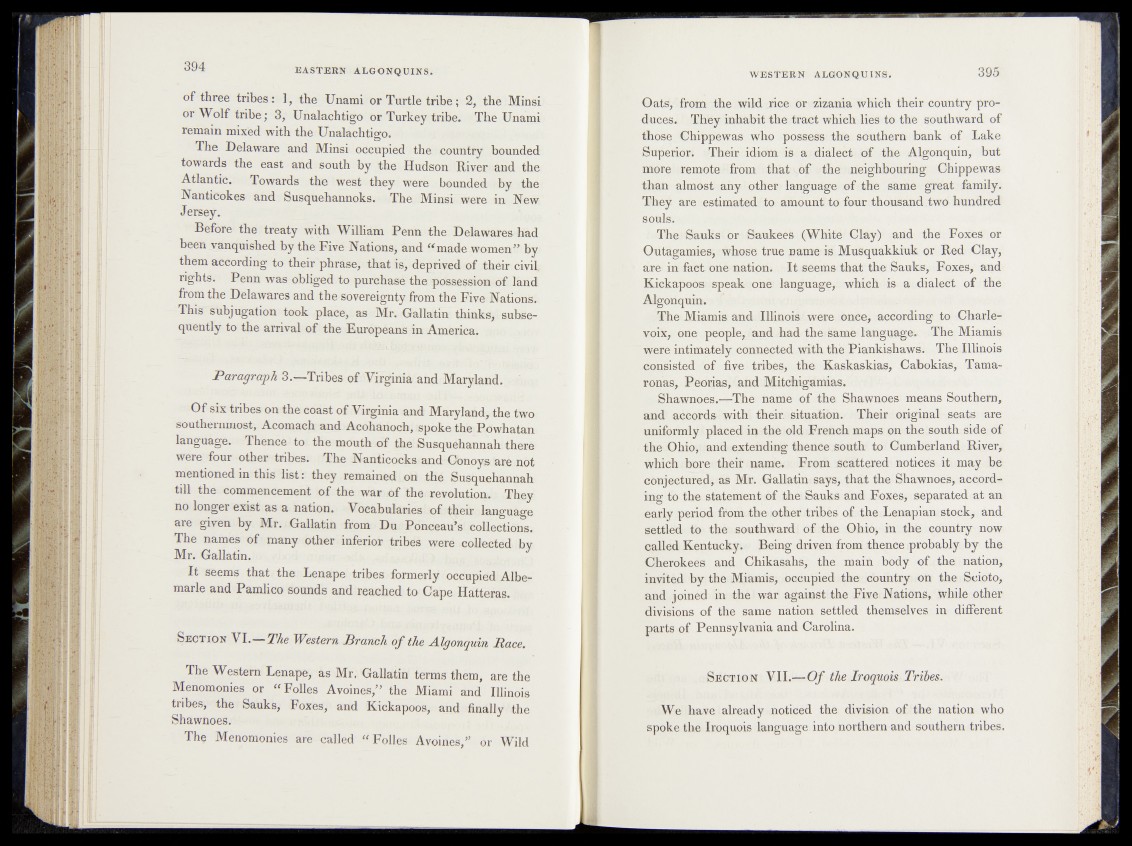
of three tribes : 1, the Unami or Turtle tribe ; 2, the Minsi
or Wolf tribe; 3, Unalachtigo or Turkey tribe* The Unami
remain mixed with the Unalachtigo.
The Delaware and Minsi occupied the country bounded
towards the east and south by the Hudson River and the
Atlantic. Towards the west they were bounded by the
Nanticokes and Susquehannoks. The Minsi were in Now
Jersey*
Before the treaty with William Penn the Delawares had
been vanquished by the Five Nations, and "made women” by
them according to their phrase, that is, deprived of their civil,
rights. Penn was obliged to purchase the possession of land
from the Delawares and the sovereignty from the Five Nations*
This subj ugation took place, as Mr. Gallatin thinks, subsequently
to the arrival of the Europeans in America.
Paragraph 3.—Tribes of Virginia and Maryland.
Of six tribes on the coast of Virginia and Maryland, the two
southernmost, Acomach and Acohanoch, spoke the; Powhatan
language. Thence to the mouth of the Susquehannah there
were four other tribes. The Nanticocks and Cbnoys are not
mentioned in this list: they remained on the Susquehannah
till the commencement of the war of the revolution*. They
no longer exist as a nation. Vocabularies of their language
are given by Mr. Gallatin from Du Ponceau’s collections.
The names of many other inferior tribes were collected bv
Mr. Gallatin.
It seems that the Lenape tribes formerly occupied Albemarle
and Pamlico sounds and reached to Cape Hatteras.
S e c t io n VI.—The Western Branch o f the Algonquin Race.
The Western Lenape, as Mr. Gallatin terms them, are the
Menomonies or "Folles Avoines,” the Miami and Illinois
tribes, the Sauks, Foxes, and Kickapoos, and finally the
Sbawnoes.
The Menomonies are called "Folles Avoines/ or Wild
GaH from the wild rice or zizania which their country produces*
‘ They inhabit the tract which lies to the southward of
those Chippewas who possess: the southern bank of Lake
Superior. Their idiom is a dialect of the Algonquin, but
more remote Jsfrom -that \of >fhe;,aneighbouring Chippewas
than almost any other? language of the same great family.
They are estimated to amount! to four thousand .two hundred
souls.
The Sauksr. Or * Saukees (White? Clay) and the Foxes or
Outagamies, whose true name is Musquakkiuk or Red Clay,
are in fact one. nation. It seems that the Sauks, Foxes, and
Kickapoos speak one language, which I p a dialect of the
Algonquin.
The Miamis and Illinois ' were once, according to Charlevoix,
one people, and had the same language* The Miamis
were intimately connected with the Piankishaws. The Illinois
consisted of five tribes, the Kaskaskias, Cabokias, Tama-
ronas, Peorias, and Mitchigamias.
Shawnoes.—The name of the Sbawnoes means Southern,
and accords with their, situation. Their original seats are
uniformly placed in the old French maps on the south side of
the Ohio, and extending thence south to Cumberland River,
which bore* their name. * From scattered notices it may be
conjectured, as Mr. Gallatin says, that the Shawnoes, according
to the statement of the- Sauks and Foxes, separated at an
early period from the other tribes of the Lenapian.' stock, and
settled to the southward of the Ohio, in the country now
called Kentucky. Being driven from thence probably by the
Cherokees and Chikasahs, the main body of the nation,
invited by the Miamis, occupied the country on the Scioto,
and joined in the war against the Five Nations, while other
divisions of the same nation settled themselves in different
parts of Pennsylvania and Carolina.
Section VII.— O f the Iroquois Tribes.
We have already noticed the division of the nation who
spoke the Iroquois language, into northern and southern tribes.